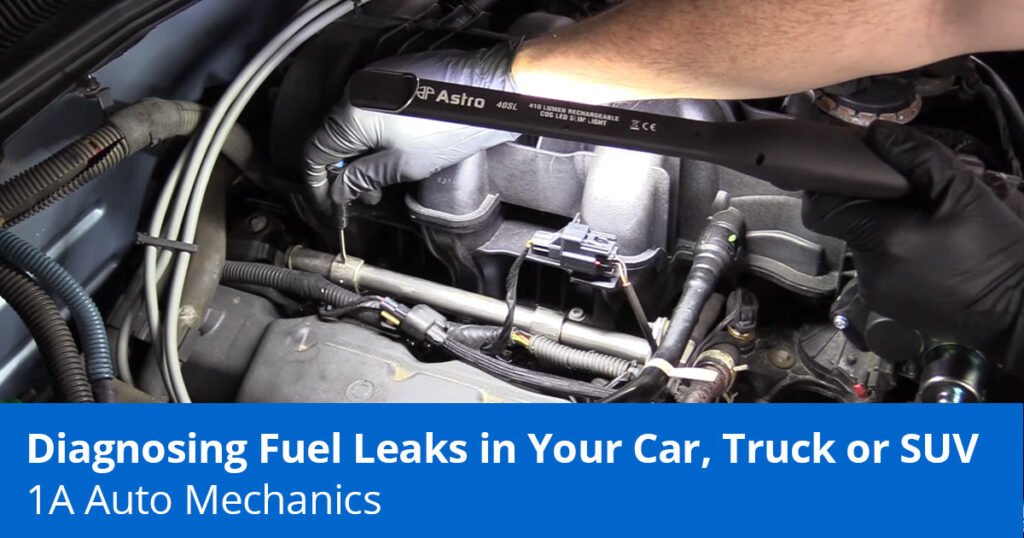
Learn to Diagnose and Fix a Fuel Leak in Your Car
If your car smells like gas, it could be an indication that gas is leaking from the fuel system. This can be very dangerous since gas puddles tend to easily catch fire. In today’s post, we’ll teach you how to diagnose fuel leaks by showing you a couple of places you can check.
What to Do If Your Car Smells Like Gas
If you notice that your car smells like gas, it’s best to stop at a safe place and check it out. You never want to keep on driving with a gas leak. Fuel is flammable. It can pose a serious safety issue when exposed to a hot engine or exhaust fumes.
How to Find Fuel Leaks That Make Your Car Smell Like Gas
Dealing with fuel means that you’ll be exposed to gas vapors that can create a nasty odor. As such, it’s best to wear your personal protective equipment for this particular diagnosis. If you notice that your car smells like gas at the front, don’t stop there. Go further to see if the issue is occurring in multiple areas.
Shop Quality Auto Parts

1. Check the Fuel Rails
Start by popping the hood of your car and take a look around your engine compartment. You’ll want to pay attention to the fuel rails. These are pipes that deliver pressurized fuel to the fuel injectors that are mounted underneath. They sit right out in the open in most cars on both sides of the engine. Some cars will have them buried underneath other parts.
Check the fuel rails for any moisture that may indicate that there’s a gas leak. Inspect all joints carefully as you follow the piping. For places where the rails are buried under other parts, take your time as you check for fuel leaks. You can touch any moisture that you find using a gloved finger and sniff to confirm if it smells like gas.
2. Inspect the Fuel Lines
Once you’re done inspecting the fuel rails, you’ll need to find the input hose. This is a pipe that connects the fuel rails to the fuel filter/fuel pump. It has a connector along its route. Check to see that it is tight and that there are no fuel leaks. The input hose goes further down the vehicle. You’ll need to get underneath the car to follow it all the way to the gas tank.
Check every connection point on the fuel lines, including where they connect to the fuel filter. If you see anything that looks like residue, it could be gas that’s leaking. Check for corrosion at the gas tank as well.
Any plastic coverings could also be hiding a fuel leak. Some fuel lines tend to rust and leak where they connect to the fuel pump. You’ll need to check those too and inspect all hoses that come out of the gas tank. Those made of rubber may be dry, brittle, or cracked.
3. Check the Fuel Injector O-Rings
If your fuel rails and lines are all good, your car may smell like gas due to fuel injector O-rings that have failed. These operate under high pressure and can wear out over time. They act as seals where the injector connects to the fuel rail and engine. You’ll need to remove the fuel injector that’s causing the leakage before replacing the damaged O-ring.
As a rule of thumb, it’s best to first relieve pressure from the fuel system. You can do this by removing the fuel pump fuse and turning on the ignition. The car may or may not run. If it does, it will only do so for a few seconds and die out.
Removing the fuse disconnects power from the fuel pump. This prevents the engine from drawing any more fuel. Once that’s done, you’ll need to remove all the mounting bolts that are holding the fuel rails down. You should then be able to carefully wiggle or pry them out to reach the fuel injectors.
Each injector will have a connector that sends power to it. You’ll need to disconnect that before pulling it out. Each injector has two O-rings – one at the top and another at the bottom. Remove and inspect them for any cracks or wear. You can use two screwdrivers to stretch them out for a better view. They’ll need to be replaced if damaged.
It’s also important to inspect the fuel injector itself. Check to see that it is not cracked. Cracks tend to spread with time and rot, causing injectors to leak fuel. You’ll also want to take a look at where the fuel comes out. If the small holes are clogged or covered by debris, you could choose to clean the area or replace the fuel injector altogether.
Car Smells Like Gas? Here are Some Parts to Fix the Problem
Related Content
- Is Your Car Using Too Much Gas?
- Gas Cap Throwing a Check Engine Light? [Diagnose & Fix]
- Do I Need Premium Gas?
- My Car Won’t Start After Getting Gas & How I Fixed It
- Why Your Gas Mileage Gets Worse in Winter & What to Do About It
- Why do Gas Prices Go Down in the Winter?
- What are the Different Types of Fuel Injection Systems?
- What Is Fuel Injection? How Does It Work?

